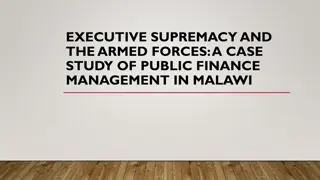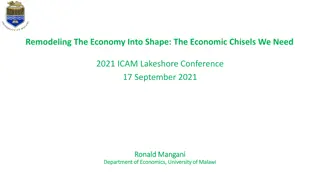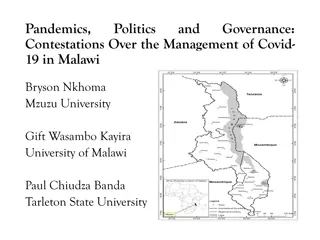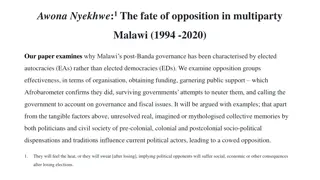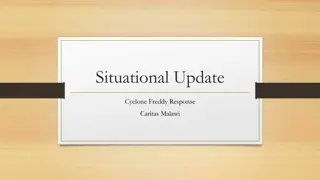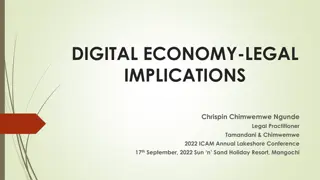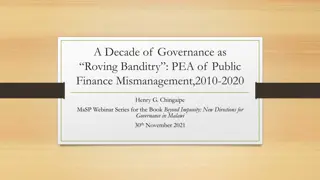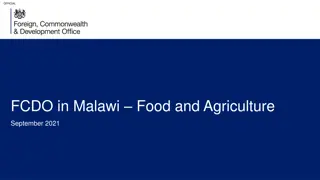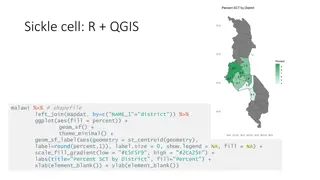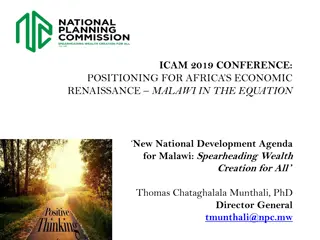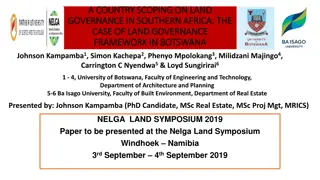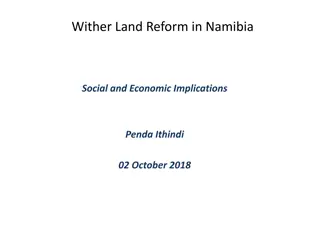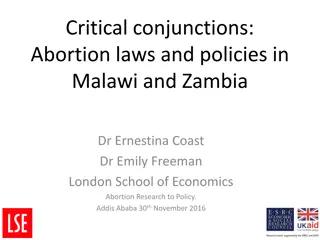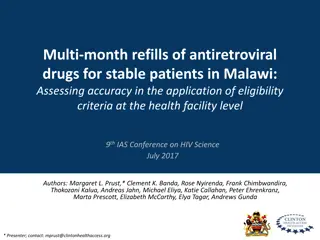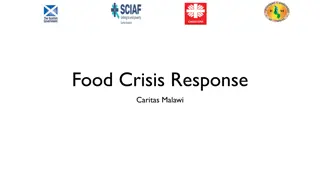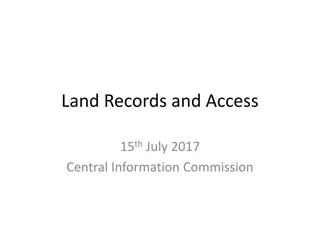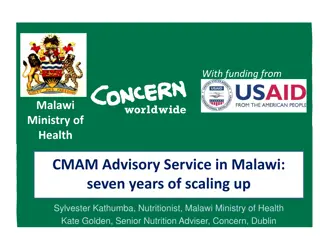Land Governance in Malawi: Challenges and Progress
Malawi's land governance system has evolved significantly since the colonial era, with a framework that includes institutional and legal aspects. The country has faced challenges in managing land disputes, valuation, taxation, and public land use. The institutional setup involves the central government, local government, and traditional authorities. Recent reforms, including the establishment of the Malawi National Land Policy and the passing of Land Bills, aim to address these challenges and improve land governance.
Download Presentation

Please find below an Image/Link to download the presentation.
The content on the website is provided AS IS for your information and personal use only. It may not be sold, licensed, or shared on other websites without obtaining consent from the author.If you encounter any issues during the download, it is possible that the publisher has removed the file from their server.
You are allowed to download the files provided on this website for personal or commercial use, subject to the condition that they are used lawfully. All files are the property of their respective owners.
The content on the website is provided AS IS for your information and personal use only. It may not be sold, licensed, or shared on other websites without obtaining consent from the author.
E N D
Presentation Transcript
LAND GOVERNANCE IN MALAWI Edward Chikhwenda, Bester Kasowanjete, Patrick Kambewa,Regson Chaweza
PRESENTATION OUTLINE INTRODUCTION INSTITUTIONAL FRAMEWORK ON LAND GOVERNANCE LEGAL FRAMEWORK ON LAND TENURE LAND DISPUTE RESOLUTION VALUATION AND TAXATION LAND USE PLANNING CONTROL MANAGEMENT OF PUBLIC LAND LAND INFORMATION LAND GOVERNANCE CHALLENGES
INTRODUCTION Land Land Area Area 94,080 km 94,080 km2 2 24,404 km2 Water Water Area Area 118,484km2 Total Total Area Area 18,570,321 Population Population 197.39/km2 Population Population Density Density Presidential Republic Government Government Type Type $21.20 Billion GDP GDP (PPP) (PPP) 1,100$ GDP GDP Per Per Capita Capita
BACKGROUND Malawi land locked formerly Nyasaland (1891 to 1964) Early inhabitants were nomads Land use characterised by conquest 1884, Berlin Conference defined the current boundaries 1891 Nyasaland became British Protectorate Introduction of dualism of land tenure Categories of land: Crown, Native Trust, Private Certificate of Claim used to convert NTL into Private.
BACKGROUND At Independence, land was categorised as Public, Customary and Private(Leasehold, Freehold) Malawi was under one party system from 1964 to 1994 After attaining multiparty system Commission of Inquiry on Land Reform established. Malawi National Land Policy passed in 2002. In 2016 Land Bills passed by Parliament In 2017 The President assented the Bills
INSTITUTIONAL FRAMEWORK ON LAND GOVERNANCE Original land administered based on tribal groupings 1891 marked the introduction of British Legal system Traditional versus western models resulted in conflicts Attempts to resolve land issues resulted in several commissions of inquiry Despite challenges over time, land management and administration is at three levels Levels include: 1.Central Government 2. Local Government and 3. Traditional level
INSTITUTIONAL FRAMEWORK ON LAND GOVERNANCE Minister of Lands Housing and urban Development Deputy Minister of Lands Housing and urban Development Principal Secretary Principal Secretary II Physical Planning Department Lands and Valuation Department Urban Surveys Department Housing Department Development Department Valuation Services Land Surveying Services Mapping Services Legal Services Rural Housing Estates & Valuation Urban Hydrographic & Aeronautic Services Infrastructure Estate Home Ownership Scheme Management Services Management & Support Services Forward Planning Development Control Urban Housing
INSTITUTIONAL FRAMEWORK MLHUD responsible policy formulation and implementation Local authorities responsible for implementing land related policies Local authorities governed by the decentralisation policy Other ministries involved in land management and administration e.g Ministry of Agriculture, Ministry of Irrigation and Water resources, Transport and public Works etc Institutional overlaps exist due to inconsistencies in policies
LEGAL FRAMEWORK ON LAND TENURE Historically authority to allocate land was vested in community leaders The British brought the deeds registration system as early as 1916. Land administration during colonial era was based on British Land Law 1892 African Orders in Council formulated to facilitate the acquisition and granting land rights 1894 Land Survey Regulations- urban land management 1896 Land Sales regulations purchase and leasing of land 1898 Africa(Acquisition of Lands) Order in Council-to mandate courts in Malawi to adopt British Common law
LEGAL FRAMEWORK ON LAND TENURE 1965 Land Bill-recognised land as country s greatest asset Land Act of 1965- Categorised land as Public, Customary and Private(Leasehold & Freehold) Public Land-occupied used or acquired by the government Customary Land-all land held, occupied or used under customary law Private Land-owned, held or occupied under freehold or leasehold or certificate of claim Land Registration Systems include private conveyancing, deeds registration and title registration system. Deeds registration based on Deeds registration of 1916 Title Registration is/was based on Registered Land Act of 1967(Lilongwe,Blantyre,Mzuzu, Zomba and Karonga)
LEGAL FRAMEWORK ON LAND TENURE 18th March 1996-Presidential Commission of Inquiry Land Policy Reform 2002 National Land Policy adopted (through consultative process) Malawi Land Reform Programme Implementation Strategy developed to translate NLP recommendations into actions 2016 Land Bills passed in Parliament 2017 Land related Acts assented and Gazetted Land Act of 2016 aimed at harmonizing existing legal framework with the aspirations of Malawi National Land Policy Land Act of 2016 has redefined Public Land and Private Land Customary Land Act of 2016 has been introduced.
LEGAL FRAMEWORK ON LAND TENURE CENTRAL GOVERNMENT CENTRAL LAND BOARD CENTRAL LAND BOARD DISTRICT LAND TRIBUNAL DISTRICT LAND TRIBUNAL LOCAL GOVERNMENT LAND TRIBUNAL TRADITIONAL AUTHORITY LAND TRIBUNAL GROUP VILLAGE HEADMAN GROUP VILLAGE HEADMAN GROUP VILLAGE HEADMAN VILLAGE HEADMAN LAND ALLOCATION COMMITTEE LAND ALLOCATION LAND ALLOCATION COMMITTEE LAND CLERK COMMITTEE INDIVIDUALS INSTITUTIONS CORPORATE BODIES
LAND ALLOCATION PROCESS Public Land identified Sketch Plan/Layout Plan produced and applicant fills Lease Application Form Reccords Office at Lands Department open a file Rejected Approved Regional Commissioner for Lands submits application to City Council for vetting Rejected Regional Commissioner for Lands drafts a MEMO to the Minister to approve lease application Minister grants Provisional Offer of Lease with conditions Regional Commissioner for Lands requests Surveyor General to carry out cadastral survey Surveyor General grants authority to carry out cadastral survey Government Land Surveyor carries out cadastral survey for Deed Plan production Private Lisenced Land Surveyor carries out cadastral survey for Deed Plan production Deed Plans approved by Surveyor General Regional Commissioner for Lands prepares Title Deeds in Triplicate unsing approved Deed Plans Title deeds registered Applicant granted Lease for 99 years and pays ground rent
LAND DISPUTE RESOLUTION Ambiguity of management of responsibility of different types of public land Several actors are involved in land management Prior the passing of Customary Land Act of 2016 traditional authorities were involved in land dispute resolution Tribunals at three levels(TA,District and National) In the past multiple players(chiefs, District Commissioners) Chiefs recognised under customary land Community based system were equitable but had limited/no recognition in the formal judicial system. In rural areas common disputes are inheritance/famaly followed by boundary/trespass disputes
LAND DISPUTE RESOLUTION Formal judicial system include magistrate, high court, appeal courts Procedure exists for appeal in land cases Costs are high and take too long and may never be concluded Arbitration and mediation are other procedures used to solve disputes Land disputes account for less than 10% of total cases in the formal system
VALUATION AND TAXATION Property taxes assessed based on Quinqenial Valuation Roll and Supplementary Valuation Roll Local Councils are responsible for tax collection Failure to collect taxes due to lack of capacity and resources Land tax is based on market prices Accessibility to valuation rolls because centrally kept Annual tax collections depend on amount of ratable value, rate levy and rate collection efficiency Challenges include under collection due to delays in renewal of valuation rolls and lack of capacity to enforce compliance. Parishes, churches and cemeteries are exempted from property tax while schools and hospitals are on half rate.
VALUATION AND TAXATION QVRis mainly applicable in urban areas In urban areas, informal and newly urbanised areas are also excluded Councils fail to control new developments in urban areas Lack of information on the number of properties in their jurisdiction Only 12 out of 38 local government areas are declared ratable areas Low compliance by property owners to pay taxes result in the whole process of tax collection to be very high.
LAND USE PLANNING & CONTROL Land use planning framework & process Physical Planning acts (1988) & (2016) provides for inclusive planning process however; Institutional framework is generally centralized, i.e. decentralization of the sector is slow The composition of relevant governance structures, i.e. planning committees, are experts dominated The system continues to be marred with structural issues such as; Inadequate human and financial capacity Persistence of the view that planning is a technical undertaking Inadequate political will to support the implementation of laid down regulations, i.e. Physical Planning Guidelines and Standards
LAND USE PLANNING & CONTROL Delivery of services, development permits & land use control The main deliverables of this system are; Planned and inclusive settlements Timely issued development permits Economically productive urban systems However it has been observed that in practice the situation is as follows; Delayed issuance of development permits, i.e. months after the specified period of 30 days In 2011 about 70 per cent of the urban population in Blantyre city & elsewhere lived in unplanned/informal settlements Majoring of the urban residents in cities of Malawi earn their income from the informal sector where security of land tenure is a major issue
LAND USE PLANNING & CONTROL Climate change & environmental management Climate change & environmental management The role of planning in dealing with issues of climate change and environmental management is rarely recognized Most unplanned settlements mushrooming in cities of Malawi are located in environmentally sensitive areas, i.e. floodplains & river banks This is caused in part by; Poor monitoring and enforcement of approved plans Lack of access to serviced land by the urban poor Questionable land use decisions on the part of potential developers where economic considerations override disaster risk concerns
LAND GOVERNANCE CHALLENGES Malawi has developed a comprehensive institutional and legal framework However, there is lack or limited enforcement Construction of infrastructure road reserves Encroachment of public land Illegal developments on public land Cultivation on road reserves Planning standards and regulation inaccessible to the majority Administrative steps, cost and time required to register on public land Complexities of land registration is a bleeding place for corruption
LAND GOVERNANCE CHALLENGES New legislation not addressed general principles to promote access to customary land CLA 2016 given responsibilities of customary land governance to an elected body based on western democratic principles Despite legislative and policy reforms access to land is still mediated by men both in patrilineal and matrilineal societies Infrastructure development on development on public land Development without planning permission result in service delivery to be difficult and costly Political interference poses as a challenge to both the institutional and legal frameworks Squatter settlements have negative impacts on infrastructure development and management
LAND GOVERNANCE CHALLENGES Land acquisition process is bureaucratic and time wasting Result in corruption Lack of transparency and efficiency in land access result in corruption Lack of comprehensive land information system Lack of comprehensive land profile Accessibility of land registration information is missing Overlapping responsibilities result mix-ups between institutions in terms of their roles and responsibilties Policy overlaps Overlaps between different levels administration.


